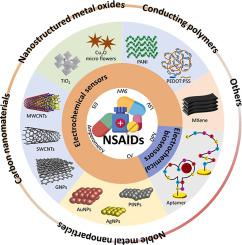Trends in Analytical Chemistry ( IF 11.8 ) Pub Date : 2021-07-31 , DOI: 10.1016/j.trac.2021.116403 Pramod K. Kalambate , Julaluk Noiphung , Nadnudda Rodthongkum , Nutcha Larpant , Pannawich Thirabowonkitphithan , Theerasak Rojanarata , Mohammed Hasan , Yunhui Huang , Wanida Laiwattanapaisal

|
Non-steroidal anti-inflammatory drugs (NSAIDs) are the most frequently administered over-the-counter medicines to treat fever, pain and control inflammation. However, their overdose can cause detrimental effects in the human body, whereas uncontrollable disposable into ecosystems pose significant environmental concerns. Electrochemical (bio) sensors overcome the limitations of traditional detection approaches and provide immense potential for sensitive, selective, efficient, and low-cost detection of pharmaceuticals in complex media. This review presents an overview of the current state-of-the-art progress in electrochemical (bio) sensors utilizing nanoscale materials (e.g., metal/metal oxides nanoparticles, carbonaceous materials, and conducting polymers) as electrode modifiers that target NSAIDs. Special attention is paid to different electrode fabrication strategies, sensor/analyte interactions, and analysis of real-world samples. Besides, experimental conditions and some analytical parameters including linear concentration range, detection limit, detection method, etc., are compiled and compared. Finally, this review concludes by discussing future prospects, challenges, and possibilities in designing next-generation advanced sensing devices.
中文翻译:

基于纳米材料的电化学传感器和生物传感器用于检测非甾体抗炎药
非甾体类抗炎药 (NSAID) 是最常用于治疗发烧、疼痛和控制炎症的非处方药。然而,它们的过量服用会对人体造成不利影响,而无法控制的一次性进入生态系统会造成严重的环境问题。电化学(生物)传感器克服了传统检测方法的局限性,为复杂介质中药物的灵敏、选择性、高效和低成本检测提供了巨大的潜力。本综述概述了电化学(生物)传感器利用纳米级材料(例如,金属/金属氧化物纳米粒子、含碳材料和导电聚合物)作为靶向 NSAID 的电极改性剂的当前最新进展。特别注意不同的电极制造策略、传感器/分析物相互作用以及真实世界样品的分析。此外,还对实验条件和线性浓度范围、检出限、检测方法等一些分析参数进行了整理和比较。最后,本综述最后讨论了设计下一代先进传感设备的未来前景、挑战和可能性。











































 京公网安备 11010802027423号
京公网安备 11010802027423号